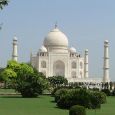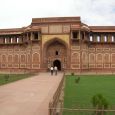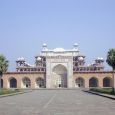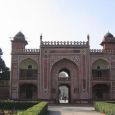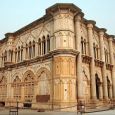Agra
Advertisement
Air
Agra Airport is about 12.5 km from city center
Rail
Agra is on the main train line between Delhi (Station Code: NDLS) and Mumbai (Bombay) (Station Code: CSTM) and between Delhi and Chennai (Station Code: MAS) and many trains like Bhopal Shatabdi, Bhopal Express, Malwa Express, Gondwana Express, Jabalpur - Jammutawi Express, Shreedham Express etc. connect Agra with all major Indian cities like New Delhi, Mumbai, Kolkata, Chennai, Hyderabad, Bengaluru, Pune, Bhopal, Indore, Gwalior, Jabalpur, Ujjain, Jaipur, Lucknow etc. every day. Some east-bound trains from Delhi also travel via Agra, so direct connections to points in Eastern India (including Kolkata) (Calcutta) are also available. There are close to 20 trains to New Delhi and Gwalior Junction every day, and at least three or four to Bhopal, Indore, Nagpur, Mumbai and Chennai. There are three main railway stations in Agra:
Agra Cantt Railway Station
* Agra Cantt (Station Code: AGC) is the main railway station and lies southwest of the Taj and Agra Fort, both of which are a short ride from the station by car, auto-rickshaw, or cycle rickshaw. There's a prepaid taxi stand right outside that charges a flat Rs.120 to any hotel in the city. The station has a pretty good Comesum food court that also sells cheap, hygienic takeaway snacks (sandwiches, samosas, etc.).
* Agra Fort Railway Station (Station Code: AF) near Agra Fort, is infrequently serviced by the interstate express trains, it is one of the oldest railway station in the country. The station serves trains to the east (Kanpur, Gorakhpur, Kolkata, Guwahati) and central India Ratlam, Nagda, Kota (Haldighati Express). Some of these trains also stop at Agra Cantt.
* Raja Ki Mandi (Station Code: RKM) is a small station. Some of the trains which stop at Agra Cantt also stop here. It is a very laid back station and springs into life at the arrival of Intercity Express, Mahakoshal Express, Indore - Amritsar Express and Taj Express. Other stations are Idgah, Billochpura, Agra City, Yamuna Bridge.
The luxury trains - the Palace on Wheels, and the Royal Rajasthan On Wheels also stop at Agra on their eight day round trip of tourist destinations in Rajasthan and Agra. The Buddhist Special Train also visits Agra. There is urgent need of Metro Train in Agra that connect all historical monuments (Taj Mahal, Red Fort, Sikandara [Tomb of Akbar], I'timād-ud-Daulah's Tomb and Radha Swami Temple). It will give thrust to tourism as well as provide efficient and rapid public transport.
Road
Idgah Bus Stand and Inter State Bus Terminal (ISBT) are the major Bus Stands in Agra and is connected to most of the bigger cities in North India.
* From Delhi: NH2, a modern divided highway, connects the 200 km distance from Delhi to Agra. The drive is about 4 hours. The primary access to the highway is along Mathura Road in Delhi but, if coming from South Delhi or Delhi Airport, it is easier to take Aurobindo Marg (Mehrauli Road) and then work up to NH2 via Tughlakabad.
* From Jaipur: National Highway 11, a Four lane divided highway, connects Agra with Jaipur via the bird sanctuary town of Bharatpur. The distance of around 255 km can be covered in around 3-4 hours.
* From Gwalior A distance of around 120 km, takes around 1.5 hours on the National highway 3, also known as the Agra - Mumbai Highway.
* From Lucknow / Kanpur NH2, the divided modern highway, continues on to Kanpur (285 km, 5 hours) and from there to points East ending in Kolkata. From Kanpur, NH25 heads for the city of Lucknow (90 km, 2 hours).
Agra has a major Road named as Mahatma Gandhi(MG) Road at the ceneral part known as heart line of agra.
Taxi
Tourist can hire a taxi for local sight seeing or agra visit from local taxi stand. A prepaid taxi counter is available at agra cantt railway station.
Taj Mahal
Agra's Taj Mahal is one of the most famous buildings in the world, the mausoleum of Shah Jahan's favorite wife, Mumtaz Mahal. It is one of the New Seven Wonders of the world, and one of three World Heritage Sites in Agra.
Completed in 1653, the Tāj Mahal was built by the Mughal king Shāh Jahān as the final resting place for his beloved wife, Mumtāz Mahal. Finished in marble, it is perhaps India's most fascinating and beautiful monument. This perfectly symmetrical monument took 22 years (1630–1652) of hard labour and 20,000 workers, masons and jewellers to build and is set amidst landscaped gardens. Built by the Persian architect, Ustād 'Īsā, the Tāj Mahal is on the bank of the Yamuna River. It can be observed from Agra Fort from where Emperor Shāh Jahān gazed at it, for the last eight years of his life, a prisoner of his son Aurangzeb. It is an acknowledged masterpiece of symmetry. Verses of the Koran are inscribed on it and at the top of the gate are twenty-two small domes, signifying the number of years the monument took to build. The Tāj Mahal was built on a marble platform that stands above a sandstone one. The most elegant dome of the Tāj Mahal has a diameter of 60 feet (18 m), and rises to a height of 80 feet (24 m); directly under this dome is the tomb of Mumtāz Mahal. Shah Jahān's tomb was erected next to hers by his son Aurangzeb. The interiors are decorated by fine inlay work, incorporating semi-precious stones.
Agra Fort
Agra Fort (sometimes called the Red Fort), was commissioned by the great Mughal Emperor Akbar in 1565, and is another of Agra's World Heritage Sites. A stone tablet at the gate of the Fort states that it had been built before 1000 but was later renovated by Akbar. The red sandstone fort was converted into a palace during Shāh Jahān's time, and reworked extensively with marble and pietra dura inlay. Notable buildings in the fort include the Pearl Mosque, the Dīwān-e-'Ām and Dīwān-e-Khās (halls of public and private audience), Jahāngīr's Palace, Khās Mahal, Shīsh Mahal (mirrored palace), and the Musamman Burj. Reference required
The great Mughal Emperor Akbar commissioned the construction of the Agra Fort in 1565 CE., although it was converted into a place by his grandson Shāh Jahān, being reworked extensively with marble and pietra dura inlay. Notable buildings in the fort include the Pearl Mosque or Motī Masjid, the Dīwān-e-'Ām and Dīwān-e-Khās (halls of public and private audience), Jahāngīr's Palace, Khās Mahal, Shīsh Mahal (mirrored palace), and the Musamman Burj. The forbidding exteriors of this fort conceal an inner paradise. The fort is crescent shaped, flattened on the east with a long, nearly straight wall facing the river. It has a total perimeter of 2.4 kilometres (1.5 mi), and is ringed by double castellated ramparts of red sandstone punctuated at regular intervals by bastions. A 9 metres (30 ft) wide and 10 metres (33 ft) deep moat surrounds the outer wall.
Chhatrapati Shīvajī visited the Agra Fort, as a result of the conditions of the Treaty of Purandar entered into with Mirzā Rājā Jaisingh to meet Aurangzeb in the Dīwān-i-Khās (Special Audience Chamber). In the audience he was deliberately placed behind men of lower rank. An insulted Shīvajī stormed out of the imperial audience and was confined to Jai Sing's quarters on 12 May 1666. Fearing the dungeons and execution he escaped on 17 August 1666. A heroic equestrian statue of Shīvajī has been erected outside the fort.
I'timad-Ud-Daulah
The Empress Nūr Jahān built I'timād-Ud-Daulah's Tomb, sometimes called the 'Baby Tāj', for her father, Mirzā Ghiyās Beg, the Chief Minister of the Emperor Jahāngīr. Located on the left bank of the Yamuna river, the mausoleum is set in a large cruciform garden criss-crossed by water courses and walkways. The mausoleum itself covers about 23 square metres (250 sq ft), and is built on a base about fifty meters square and about one meter high. On each corner are hexagonal towers, about thirteen meters tall. Small in comparison to many other Mughal-era tombs, it is sometimes described as a jewel box. Its garden layout and use of white marble, pietra dura, inlay designs and latticework presage many elements of the Tāj Mahal.
The walls are white marble from Rajasthan encrusted with semi-precious stone decorations - cornelian, jasper, lapis lazuli, onyx, and topaz in images of cypress trees and wine bottles, or more elaborate decorations like cut fruit or vases containing bouquets. Light penetrates to the interior through delicate jālī screens of intricately carved white marble.
Many of Nūr Jahān's relatives are interred in the mausoleum. The only asymmetrical element of the entire complex is that the tombs of her father and mother have been set side-by-side, a formation replicated in the Taj Mahal.
Akbar's Tomb, Sikandra
Sikandra, the last resting place of the Mughal Emperor Akbar the Great, is on the Delhi-Agra Highway, only 13 kilometres from the Agra Fort. Akbar's tomb reflects the completeness of his personality. The vast, beautifully carved, red-ochre sandstone tomb with deers, rabbits and langurs is set amidst a lush garden. Akbar himself planned his own tomb and selected a suitable site for it. To construct a tomb in one's lifetime was a Turkic custom which the Mughals followed religiously. Akbar's son Jahāngīr completed construction of this pyramidal tomb in 1613. The names of the Gods of ninety-nine religious sects have been inscribed on the tomb.
Swami Bagh Samadhi
The Swāmī Bāgh Samādhi is a monument to hold the ashes of Huzūr Swāmijī Mahārāj (Shrī Shiv Dayāl Singh Seth) in the Swāmībāgh section, on the high road that goes from Bhagwan Talkies to Dayāl Bāgh, in the outskirts of the city. He was the founder of the Radhāswāmī Faith and the Samādhi is sacred to its followers. Construction began in February 1904 and still continues. Many believe that construction will never end at Swāmī Bāgh - it is often seen as the next Tāj Mahal. The carvings in stone, using a combination or coloured marble, are life-like and not seen anywhere else in India. The picture shown is taken from the rear of the building and shows only two floors. When completed, the Samādhi will have a carved dome and a gateway.
Upcoming Events in Agra
Taj Balloon Festival
The Taj Balloon Festival a unique 3-day extravaganza Starting 29th Oct, 2015 that recreates the pageantry and elegance of the Mughal era, whilst setting new benchmarks in the realm of lifestyle tourism. Do Visit if You are Aorund Agra during this time.
Information not available


